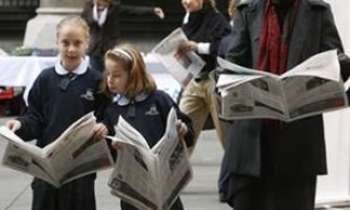ADD ANOTHER REASON for newspaper companies to worry: It's now more expensive to buy the paper on which to print the words that fewer people are reading.
Newsprint prices climbed about 11% in August and September as a host of commodity prices were pushed up by rising energy costs. Throw in worsening demographics – 55 is the average age of a newspaper reader, according to a Carnegie Corp. survey – along with declining circulation and the news is barely fit to print.
On Tuesday, Gannett (GCI), the country's largest publisher of newspapers, reported third-quarter earnings of $1.13 a share, a 4% decline from the same period a year ago. Three other newspaper giants, E.W. Scripps (SSP), Tribune (TRB) and Knight Ridder (KRI), report their earnings this week – and expectations are mixed.
Tribune, which has in the past drawn praise for its ability to adapt to the rapid changes in the media industry, is expected to post earnings of 48 cents a share, a 5% decline year-over-year, on Thursday before the market opens.
Knight Ridder is slated for a 25% slide to 66 cents a share, when it releases earnings on Friday before the market opens.
E.W. Scripps, which also reports Friday morning, is expected to post solid results – but not for reasons that would make less-diversified newspaper companies smile. Analysts are calling for a profit of 37 cents a share, up 10% year-over-year – primarily because Scripps no longer relies as heavily on its newspaper division as it once did.
"In Scripps' case, they had a lot of foresight and got into cable [television] networks back in the mid-1990s, long before they started taking off," says Joseph Bonner, an analyst at Argus Research. Scripps owns DIY Network, Fine Living, the Food Network, Great American Country and Home & Garden Television. These networks account for as much as 40% of Scripps' revenues, while its newspapers, which include the Cincinnati Post, make up about 31% of its revenues. Local television stations account for most of the rest of its revenue, which Wall Street expects to hit $7.5 billion in 2005, a 2% increase from 2004. That diversified revenue stream is a major reason why Scripps' stock is up 3% for the year to date, while Gannett, where newspaper advertising accounts for 68% of revenues, is down 19% over the same period. (Bonner doesn't own shares of any of these companies; Argus doesn't do investment banking.)
Shares of Tribune, where newspapers make up 70% of revenues, are down 22% this year. Knight Ridder, where newspapers make up 96% of revenues, has seen its stock dip 16%.
Gannett executives were surprisingly upbeat during a Tuesday conference call with Wall Street analysts and investors, pointing out that domestic national advertising climbed 7% in September from the same period a year ago, reversing a crippling industry trend. Much of Gannett's troubles come from a decline in advertising in the company's 17 newspapers in the United Kingdom, which accounts for 19% of its publishing revenue. Total sales rose 4.1% to $1.9 billion, though some of that was attributed to acquisitions, and a swap of newspapers in Idaho, Washington and Florida.
Gannett, which publishes USA Today and has papers in smaller markets throughout the United States, was able to lock in newsprint on a six-month contract, which should help blunt pricing volatility, said Jim Peters, an equity analyst at Standard & Poor's. "That's one of the costs they managed particularly well," he said. "What affected them more this quarter was revenue on the growth side [among U.K. papers]. On the good side, [having overseas operations] does diversify them, but on the bad side, when it's not going well, it hurts."
Tribune, which gets 30% of revenues from its broadcasting operations and ownership of the Chicago Cubs baseball team, has been hit hard by a circulation scandal at Newsday and Spanish-language daily Hoy, and has had to cut its ad rates to atone for inflating the number of papers it was selling. And the company was hit last month with an adverse legal decision stemming from the 1998 purchase of Times-Mirror, the former publisher of the Los Angeles Times and Newsday. The United States Tax Court disallowed the tax-free reorganization of Times-Mirror legal publishing unit Matthew Bender, which could put Tribune on the hook for as much as $1 billion in unpaid taxes. The company announced Sept. 28 it will appeal the ruling.
The industry's woes are most apparent at Knight Ridder, where profits are freefalling. The company warned on Sept. 5 that third-quarter earnings would plunge to around 65 cents a share from 88 cents a share a year ago. Analysts at the time were expecting 89 cents a share. Damage to the Biloxi Sun Herald, on Mississippi's Gulf Coast, hurt the company, on top of the structural issues affecting the industry.
"It's a less diversified operation," says Peters. "They're almost all publishing, and when you've got a sector that's out of favor and little diversification, that's not going to help. It's tougher to envision an immediate turnaround."









